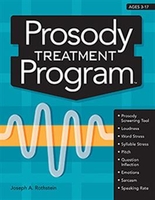Prosody Treatment Program
Prosody Treatment Program
Ages: 3-17
Grades: PreK-12
Improving receptive and expressive fundamental prosodic skills means your student will communicate emotions and attitudes, mark the most important parts of his messages, indicate a question or statement, and much moreall without adding additional words.
Most typically-developing children have mastered the functional aspects of prosodic expression by age five (Wells, Peppe, & Goulandris 2004). However, students with autism, apraxia of speech, Williams syndrome, dysarthria, and other disorders often present with speech that is monotone, robotic, or overly dramatic. They may find it hard to understand others' use of prosody.
Receptive and expressive systematic cues adapted from the dynamic temporal and tactile cueing (DTTC) hierarchy by Strand, Stoeckel and Baas, 2006 are an integral part of this best-practice program.
Prosody Treatment Program is presented in two sections: Preschool and School Age. The audio CD contains files that can be used during specific activities and faded as you become familiar with how to model the prosodic patterns.
Section 1: Preschool
This section is appropriate for working with children ages 3-5. The activities target rhythm, pitch, vocal tone, voice manipulation, melodic patterns, whisper voice, and inflections.
- Music activities are natural and fun ways to develop rhythm and pitch. Students are motivated to produce vocal inflections as they sing. The simple song melodies use common functional phrases.
- The naturalistic and functional strategy of using character voices develops the use of vocal tones. Preschoolers distinguish story characters by changing tone: deep tones for monsters, squeaky tones for mice, high pitch for babies, etc.
- Producing animal sounds develops voice manipulation skills. Preschoolers listen to and imitate animal sounds in a fun guessing game format.
- Playing musical instruments develops rhythm and pitch; the concepts slow/fast and quiet/loud, and melodic patterns.
- Using expressions develops inflection. Activities are designed to naturally encourage expressions like wheee!, yum!, ewww!, etc.
- Additional ideas and clinician tips make it easy to prepare every lesson and maximize progress. Implementing prosodic treatment early can avoid and/or reduce speech that sounds artificial.
Section 2: School Age
This section is appropriate for working with children ages 5-18. It includes the Prosody Screening Test and activities that provide:
- instruction and practice for improving prosodic skills in the areas of loudness, pitch, and rhythm
- quick overviews and directions
Therapy activities target the skills on the screening test, and include:
- Loudnessstudents learn why it's important to control the loudness of their voices based on location, proximity to a conversational partner, and the nature of the conversation. They also learn how word and syllable stress change and influence meaning of individual words.
- Pitchstudents learn to identify and use high and low pitch to ask a question, make a comment, or give a command. They learn how pitch gives listeners clues about a speaker's emotion and how changes in their pitch can convey emotion. Students also learn to interpret and use sarcasm.
- Rhythmstudents learn to recognize and use the rhythmic components of speaking rate and chunking. These skills are critical to helping listeners understand the meaning of what the speaker is saying.
- Homeworkthe activities in this section are designed to help students transfer their prosody skills outside of therapy.
- Prosody Screening TestThis
test, for students ages 5-18, is designed to give you useful
information about your clients to establish baseline data, write
treatment goals, and measure progress. This test examines:
- Loudness
- Word Stress
- Syllable Stress
- Question Inflection
- Emotions
- Chunking
- Sarcasm
98-pages • 8.5 x 11, softcover book with reproducible activities plus audio files of listening tasks • ©2013



